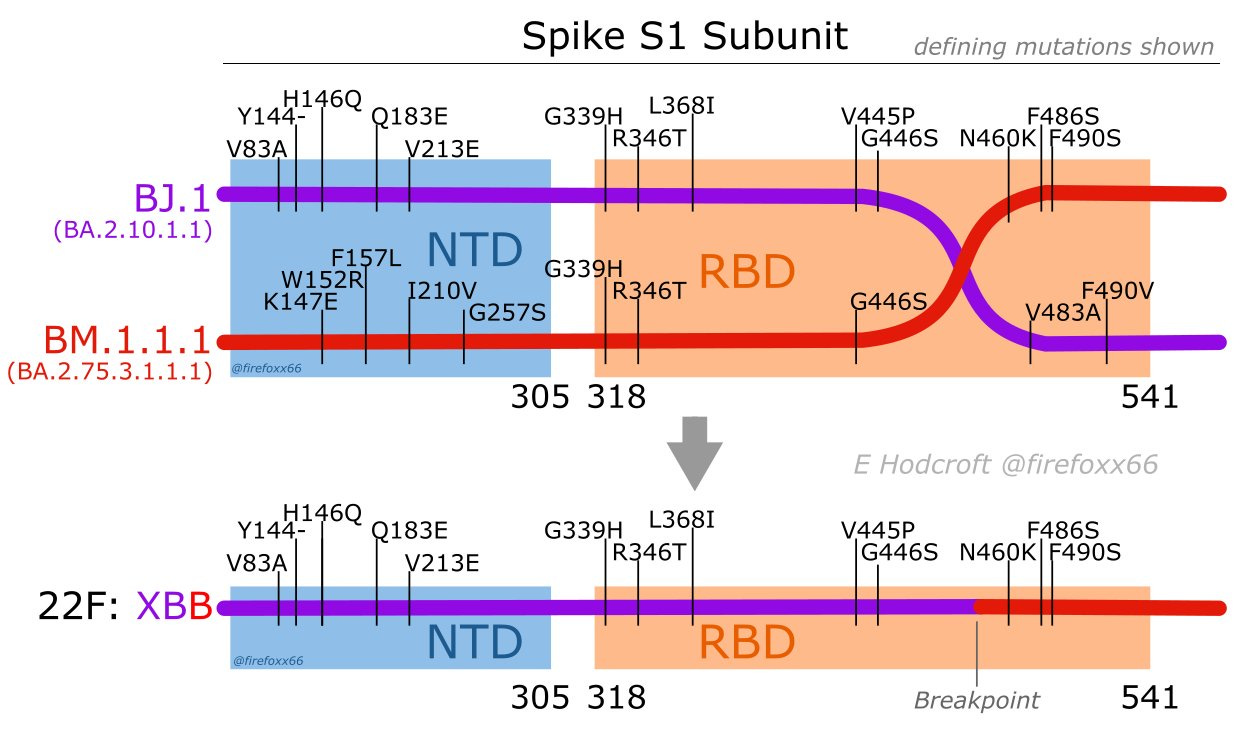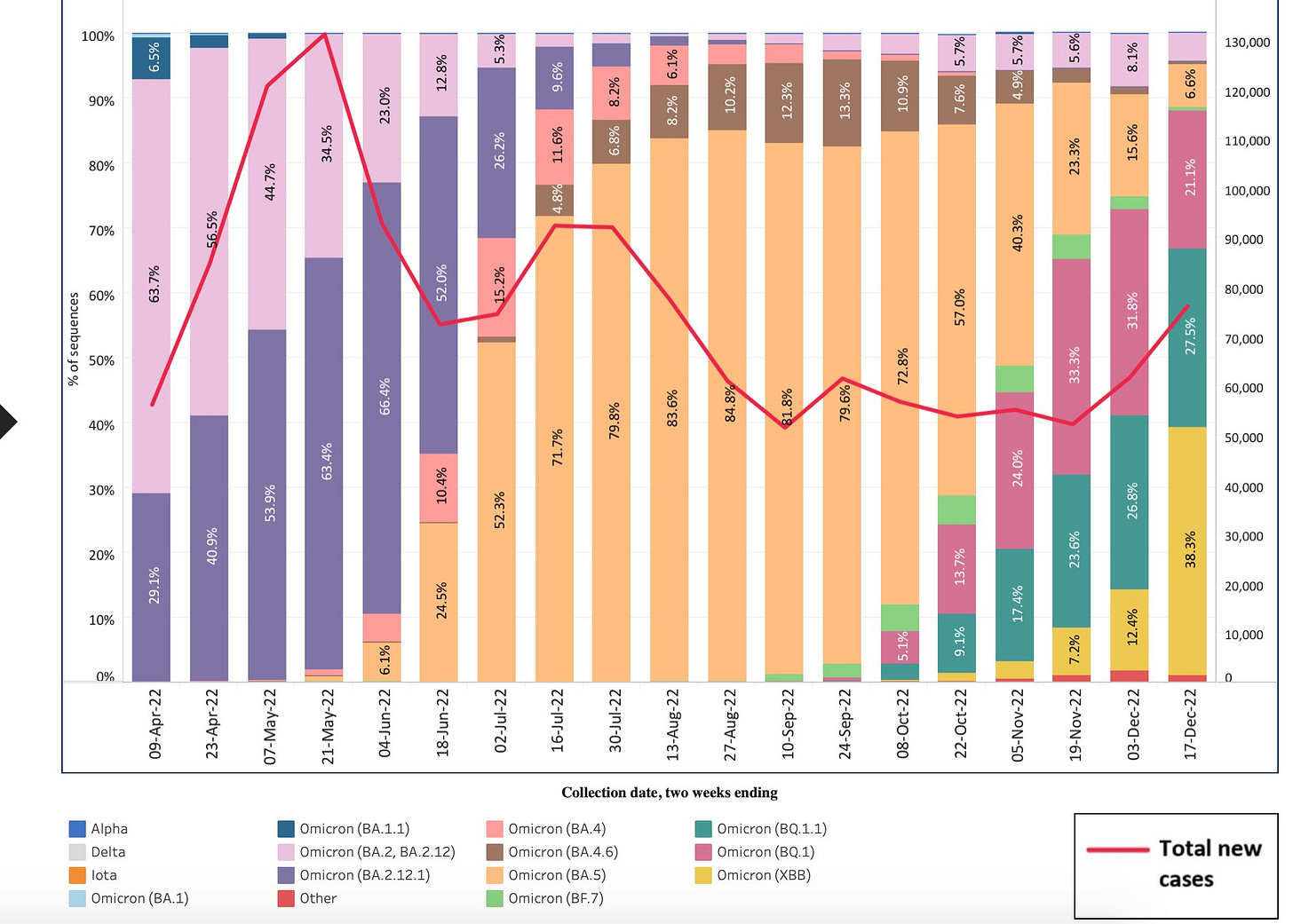As everyone who has been following the Omicron family of SARS-CoV-2 descendants in recent months, there’s a swarm of new subvariants. One of these is XBB, which is a recombinant (fusion) of 2 different BA.2 variants, BJ.1 (BA.2.10.1.1) and BA.2.75 (BA.2.75.3.1.1.1), depicted below by both the tree and mutation map.

Dr. Emma Hodcroft also has a terrific diagram to show the recombination between 2 variants that resulted in XBB
Now it appears that in New York State, XBB evolved further to XBB.1.5, with new mutations, which was aptly first noted by JP Weiland a couple of weeks ago, coincident with the beginning of a steep rise of hospitalizations there.
The key mutation of XBB.1.5 is clearly F486P, which had been identified many months ago by the Bloom lab as one that would be tied to immunity escape and Ryan Hisner wrote about extensively in August. As you can see from Daniele Focosi’s convergent variant map of the BA.2 descendants, XBB.1.5 is one to acquire the F486P mutation.
As Jesse Bloom warned us from their comprehensive screening of spike protein nucelotides, “Watch those sites for future mutations!” (see 486 below) As Ryan Hisner very recently posted: “F486P is a hell of a mutation, as Jesse Bloom’s lab RBD heat map made clear many months ago. It's the #1 AA residue for RBD expression and ACE2 binding strength. It just took the virus a while to get over the 2-nuc-mutation barrier.”
Of all the variants in the current mix, XBB.1.5 has the most growth advantage vs. BA.5 with substantial dropdown for the others as seen in the Cov-spectrum Table below, and a large number of sequenced samples to narrow the confidence intervals (CI).
Now that is playing out in New York and the Northeast regions of the United States. Back on December 13, Raj Rajnarayanan posted the comparison of XBB.1.5 vs BQ.1.1 in New York State showing the marked growth advantage.
Here is the most updated variant mix in New York through December 17th showing the rise of XBB.
In the new CDC genomic surveillance, you can see the rise of XBB that has now stunted BQ.1’s growth pattern. That is to say that BQ.1’s dominance is static while XBB is on the move.
You can see this better in the Northeast regions where XBB has already become dominant (>50%), a jump from ~35% last week. While we don’t have the sequence data to say it is the XBB.1.5 variant specifically, all indications would suggest that is indeed leading the pack within the XBBs.
If XBB.1.5 has such rapid growth advantage over BQ.1.1, that isn’t a good sign. Last week, David Ho’s lab at Columbia University published a paper in Cell entitled “Alarming antibody evasion properties of rising SARS-CoV-2 BQ and XBB subvariants.” We had known from Yunlong Cao’s lab that XBB and BQ.1.1 were among the most immune evasive variants seen to date, but this new paper established that the immune evasion for XBB.1 is more than BQ.1.1. Today, Yunlong Cao just posted new data (bottom panel below) to show that XBB.1.5 is not more immune evasive than XBB (good) but it has tighter bind to its ACE2 receptor, which would explain its higher level of transmissibility.
This XBB.1.5 variant is yet another stepwise mutations (now 9) from BA.2 with the fusion as noted above, and well seen in this newly revised Figure by Rodrigo Quiroga (@rquiroga777) with F486P representing the 9th mutation.
JP Weiland compared the effective reproduction number (Rt) for XBB.1.5 with XBB and multiple other variants over time since each started spreading (below New York data). “XBB.1.5 appears faster and more sustained than ANY of the variants since Omicron's first wave[BA.1] last January.”
What does all this mean?
The United States is the first country to have a XBB.x (subvariant) become dominant regionally following Singapore’s XBB. Singapore had a significant wave in October
as shown here for cases and deaths. Fortunately, there was some uncoupling of the case-to-death ratio from its previous waves. It should also be noted that Singapore has one of the highest vaccination and booster rates in the world (compared with the United States below).
New York is the bellwether for what is happening with XBB.1.5 and it doesn’t look good with a marked rise in hospitalizations, especially among seniors, in recent weeks as this variant has been taking hold. Of course, other factors are likely contributing such as waning of immunity, indoor/holiday gatherings, cold weather, lack of mitigation. But it is noteworthy that New York’s Covid hospital admission rate is the highest since late January (and also exceeds the summer 2021 Delta wave, but with some ambiguity as to how hospitalization were categorized then and now).
So we don’t know for sure how much of this is being driven by XBB.1.5, but it doesn’t look favorable. It is at the very least contributing—too much of a coincidence to see such a striking rise of the variant along with New York’s data. But only time will tell in the weeks ahead in contiguous states with XBB dominance how this will play out. Connecticut may indeed be showing the effect among people age 70+, as is New Jersey.
What can be done about it?
This week in NEJM, the Emory group published the data on the bivalent BA.5 booster and how it helped against XBB: "Persons who received the BA.5-containing bivalent booster had better neutralizing activity against all Omicron subvariants (especially against BA.2.75.2, BQ.1.1 and XBB) than those who received 1 or 2 monovalent [original] boosters." This finding of some cross-immunity protection has been backed up by live virus lab studies by 3 other groups.
Although we don’t know precisely how well the bivalent booster does against XBB.1.5 yet, the new lab data, showing lack of added immune evasiveness, supports there would be cross-immunity protection (just as seen with XBB). So if you haven’t had a booster in the past 4+ months, this would be well advised. Other than the bivalent booster, it’s the usual stuff of high quality masks, ventilation, air filtration, testing, etc. My podcast this week with Professor Linsey Marr, my go-to expert on air—virus transmission and a great explainer is well worth a listen (transcript coming soon) for the value of masks and how to reduce spread.
XBB.1.5 is not a welcome addition to the holiday season, to say the least. The purpose of this post is to raise awareness of its existence and trajectory, and to keep your guard up. As the editorial in Nature published today was titled: “There’s no room for COVID complacency in 2023.” While there’s still much to learn about this variant, it doesn’t have the look of a “scariant” (a term I coined in the pandemic for variants that have no functional significance but scare us). This one is the real deal and we’re betting on our immunity wall of infections, vaccinations, boosters and their combinations to help withstand its impact.
I hope you find this information and perspective is helpful.
Wishing you and yours a happy holiday season and the best for 2023



















